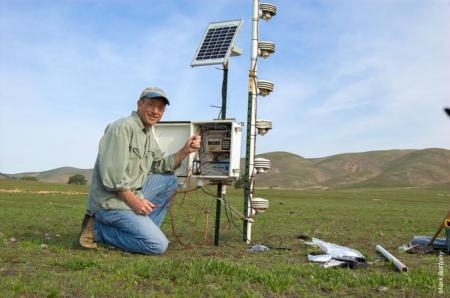On typical days, the air near the ground is warmer than the air above it. This is because the atmosphere is heated from below as solar radiation warms the Earth's surface. A surface inversion occurs when the atmosphere at the earth's surface is colder than the layer above it. There are four common causes of surface inversions, some of which can occur at the same time. Remember - inversions flow like water:
Advection of cool air:
A slab of cool air slides into and under a warmer air mass. This "drainage inversion" can occur when there are sea breezes, cold fronts or when cool air drains downhill into warmer air.
Advection of warm air:
Warm air flows over cool surfaces and lower layers cool more rapidly than those above.
Shading:
Shading from trees as well as from rolling terrain can cause an inversion to set in earlier and stay later.
Radiation cooling:
Around sunset, the ground cools rapidly by radiating heat upwards into space. The air in contact with the ground cools by conduction, causing the lowest layer of air to be cooler than higher layers. Air within this "radiation inversion" tends to remains in place.
Radiation inversions create problems for spray operators because they can cause pesticide spray to:
- stay concentrated for long periods over the target,
- move with the cool air for many miles when the breeze picks up,
- drain down slopes and concentrate in low-lying regions,
- drift unpredictably as the inversion dissipates during the morning
Radiation inversions happen every day and should always be expected to begin 3-4 hours before sunset, reach their apex just before sunrise and then dissipate no longer than an hour or so after sunrise… unless one or more of the following conditions occur:
- There is continuous overcast, low and heavy cloud.
- There is continuous rain.
- Wind speed remains above 7 m/h for the whole period between sunset and sunrise - although even this isn't always true.
Field air temperatures are often very different from local or regional forecasts, so the most reliable method of detecting inversion conditions is to measure temperatures at, and several meters above, the ground. Spray operators can recognize a surface inversion when:
- there is a big difference between the daytime and night time temperatures,
- evening and night time wind speeds are considerably less than during the day,
- sounds seem to carry further,
- odors seem more intense,
- daytime cumulus clouds tend to collapse toward evening,
- overnight cloud cover is 25% or less,
- mist, fog, dew and frost occur
- smoke or dust hangs in the air and/or moves laterally in a sheet.
If you suspect there's an inversion, then don't spray. Often, it's right on the label.
Farm Advisor Mark Battany measuring inversions
Attached Images:
